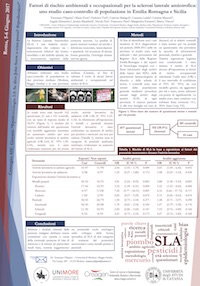Mandrioli J, Michalke B, Solovyev N, Grill P, Violi F, Lunetta C, Conte A, Sansone VA, Sabatelli M, Vinceti M
Neurodegener Dis. 2017 May 6;17(4-5):171-180
Abstract
BACKGROUND: Although an increasing role of genetic susceptibility has been recognized, the role of environmental risk factors in amyotrophic lateral sclerosis (ALS) etiology is largely uncertain; among neurotoxic chemicals, epidemiological and biological plausibility has been provided for pesticides, the heavy metal lead, the metalloid selenium, and other persistent organic pollutants. Selenium involvement in ALS has been suggested on the basis of epidemiological studies, in vitro investigations, and veterinary studies in which selenium induced a selective toxicity against motor neurons.
OBJECTIVE: Hypothesizing a multistep pathogenic mechanism (genetic susceptibility and environmental exposure), we aimed to study selenium species in ALS patients carrying disease-associated gene mutations as compared to a series of hospital controls.
METHODS: Using advanced analytical techniques, we determined selenium species in cerebrospinal fluid sampled at diagnosis in 9 ALS patients carrying different gene mutations (C9ORF72, SOD1, FUS, TARDBP, ATXN2, and TUBA4A) compared to 42 controls.
RESULTS: In a patient with the tubulin-related TUBA4A mutation, we found highly elevated levels (in μg/L) of glutathione-peroxidase-bound selenium (32.8 vs. 1.0) as well as increased levels of selenoprotein-P-bound selenium (2.4 vs. 0.8), selenite (1.8 vs. 0.1), and selenate (0.9 vs. 0.1). In the remaining ALS patients, we detected elevated selenomethionine-bound selenium levels (0.38 vs. 0.06).
CONCLUSIONS: Selenium compounds can impair tubulin synthesis and the cytoskeleton structure, as do tubulin-related gene mutations. The elevated selenium species levels in the TUBA4A patient may have a genetic etiology and/or represent a pathogenic pathway through which this mutation favors disease onset, though unmeasured confounding cannot be excluded. The elevated selenomethionine levels in the other patients are also of interest due to the toxicity of this nonphysiological selenium species. Our study is the first to assess selenium exposure in genetic ALS, suggesting an interaction between this environmental factor and genetics in triggering disease onset.

